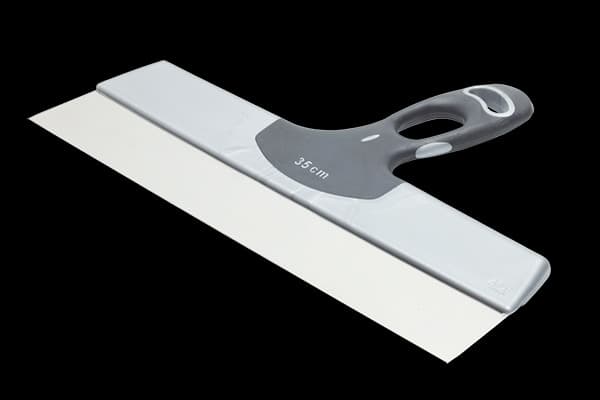جڏهن اهو اچي ٿو گهر جي سڌاري، مرمت، يا اڃا به پيشه ورانه تعميراتي منصوبن، صحيح اوزار هجڻ سان سڀ فرق اچي ٿو. اي ڀرڻ وارو چاقو ڪيترن ئي علائقن ۾ هڪ ضروري اوزار آهي، جهڙوڪ پلستر ڪرڻ، خشڪ ڪرڻ، ۽ ڀڃڻ يا سوراخ ڀرڻ. پر ڪيتريون ئي سائيزون ۽ شڪلون موجود آهن، اهو ڄاڻڻ مشڪل ٿي سگهي ٿو ته توهان جي منصوبي لاء ڪهڙو بهترين آهي. هن آرٽيڪل ۾، اسان انهن عنصرن کي ڳولينداسين جيڪي چاقو جي سائيز کي ڀرڻ جي چونڊ تي اثر انداز ڪن ٿا ۽ استعمال ڪرڻ جي فائدن جي وضاحت ڪن ٿا. وسيع ڀرڻ وارو چاقو.
ڇا آهي a ڀرڻ وارو چاقو?
A ڀرڻ وارو چاقو ھڪڙو اوزار آھي جيڪو مٿاڇري تي فلر، گڏيل مرڪب، يا پلستر لاڳو ڪرڻ لاء استعمال ڪيو ويندو آھي. بليڊ عام طور تي اسٽيل يا اسٽينلیس سٹیل مان ٺاهيو ويندو آهي ۽ مواد کي ڦهلائڻ ۽ صاف ڪرڻ لاء هڪ لوڻ واري ڪنڊ سان گڏ اچي ٿو. بليڊ جي لچڪ هڪ به پکڙجڻ جي اجازت ڏئي ٿي، جڏهن ته هينڊل جي شڪل ڪنٽرول لاءِ آرامده گرفت مهيا ڪري ٿي.
ڀرڻ وارا چاقو مختلف سائزن ۾ اچن ٿا، جن ۾ ننڍڙن، تنگ بليڊن کان وٺي ويڪر، وسيع تائين. بليڊ جي ماپ ۽ چوٽي توهان جي ڪم جي معيار ۽ ڪارڪردگي تي اثر انداز ڪري سگهي ٿي، هٿ تي ڪم تي منحصر ڪري ٿو.

غور ڪرڻ جا عنصر جڏهن هڪ ڀرڻ واري چاقو کي چونڊيو
جڏهن هڪ لاء بهترين سائيز چونڊيو ڀرڻ وارو چاقو، غور ڪرڻ لاءِ ڪجھ اهم عنصر آھن:
-
پروجيڪٽ جو قسم
ڀرڻ واري چاقو جي ماپ کي ڪم جي ماپ سان ملائڻ گهرجي. جيڪڏهن توهان هڪ ننڍڙي مرمت تي ڪم ڪري رهيا آهيو يا هڪ ننڍڙو شگاف ڀرڻ، هڪ تنگ چاقو توهان کي فلر کي صحيح طور تي لاڳو ڪرڻ جي اجازت ڏيندو. بهرحال، وڏن منصوبن لاءِ، جيئن ته وسيع ديوار وارن علائقن کي ڍڪڻ يا وڏي پيچ کي هموار ڪرڻ، وسيع ڀرڻ وارو چاقو بهتر ڪوريج ۽ ڪارڪردگي فراهم ڪندو. -
سطحي علائقو
سطح جي سائيز تي غور ڪريو جنهن تي توهان ڪم ڪري رهيا آهيو. ننڍڙن، محدود علائقن لاءِ، جيئن ته سڪل وال ۾ سوراخ يا ڪاٺ ۾ ٽڪر، هڪ تنگ ڀرڻ وارو چاقو (عام طور تي 2-3 انچ) وڌيڪ منظم آهي. پر جيڪڏهن توهان وڏن علائقن جهڙوڪ ڇت، ڀتين، يا وڏي خالن سان ڪم ڪري رهيا آهيو، هڪ وسيع چاقو (5-6 انچ يا وڌيڪ) توهان کي وڌيڪ جلدي ۽ آساني سان ڪم مڪمل ڪرڻ ۾ مدد ڪندو. -
مواد لاڳو ڪيو پيو وڃي
ڀريندڙ يا مرڪب جي ٿلهي ۽ مستقل مزاجي جيڪو توهان استعمال ڪري رهيا آهيو اهو پڻ اثر چاقو ڀرڻ جي پسند کي متاثر ڪري ٿو. ٿلهي ڀريندڙن کي آسان ايپليڪيشن لاءِ سخت ۽ وسيع چاقو جي ضرورت ٿي سگھي ٿي. اي وسيع ڀرڻ وارو چاقو توهان کي ٿلهي، ڳري مرڪب کي لاڳو ڪرڻ جي اجازت ڏيندو وڏين علائقن ۾ بغير ڪنهن ڇنڊڇاڻ يا اڻ برابري واري هنڌن جي. -
ڪنٽرول ۽ لچڪدار
تنگ ڀرڻ وارا چاقو وڌيڪ ڪنٽرول ۽ درستگي پيش ڪن ٿا، خاص طور تي جڏهن توهان کي تنگ هنڌن تي ڪم ڪرڻ جي ضرورت آهي. ٻئي طرف، وسيع چاقو گهٽ لچڪدار آهن پر وڏي ڪوريج مهيا ڪن ٿا. جيڪڏهن نوڪري کي پيچيده تفصيل يا هموار ختم ڪرڻ جي ضرورت آهي، ته توهان ڪم جي لحاظ کان هڪ وسيع ۽ تنگ چاقو جي وچ ۾ تبديل ڪرڻ چاهيندا.
جڏهن وائڊ فلنگ چاقو استعمال ڪجي
A وسيع ڀرڻ وارو چاقو عام طور تي وڏي پيماني تي ايپليڪيشنن لاء استعمال ڪيو ويندو آهي. هتي ڪجهه منظرنامو آهن جتي هڪ وسيع چاقو مثالي انتخاب آهي:
-
فلر جي وڏي مقدار کي ڦهلائڻ: جيڪڏهن توهان کي ڪنهن وڏي شگاف يا سوراخ کي ڍڪڻ جي ضرورت آهي drywall يا پلستر ۾، هڪ وسيع ڀرڻ وارو چاقو توهان کي مرڪب کي وڌيڪ موثر ۽ هڪجهڙائي سان پکيڙڻ جي اجازت ڏئي ٿو. اهو خاص طور تي مفيد آهي جڏهن توهان ڀريندڙ جي ڪيترن ئي تہن کان بچڻ چاهيو ٿا.
-
جوڑوں کي هموار ڪرڻ: جڏهن drywall يا پلستر بورڊ جوڑوں سان ڪم ڪري رهيا آهن، هڪ وسيع ڀرڻ وارو چاقو هڪ وڏي ايراضيءَ ۾ گڏيل مرڪب کي هموار ڪرڻ ۾ مدد ڪري ٿو بغير نظر ايندڙ لائينن کي. وسيع مٿاڇري پڻ lumps يا اڻ برابر اسپاٽ ٺاهڻ جو موقعو گھٽائي ٿي.
-
ٽيپ ۽ ڳنڍڻ: drywall سان ڪم ڪندڙ پروفيشنل فائنشرز لاءِ، ٽيپ ڪرڻ ۽ ڳنڍڻ لاءِ هڪ وسيع ڀرڻ وارو چاقو ضروري آهي. اهو يقيني بڻائي ٿو ته مرڪب لاڳو ڪيو ويو آهي آساني سان ۽ مسلسل سيمن ۾.
-
پلستر ڪرڻ: جڏهن ڀتين يا ڇت کي پلستر ڪرڻ، الف وسيع ڀرڻ وارو چاقو پلستر کي وسيع سطحن تي لاڳو ۽ صاف ڪرڻ ۾ مدد ڪري ٿي. هي اوزار وڌيڪ ڪارڪردگي مهيا ڪري ٿو، خاص طور تي جڏهن وڏن علائقن کي ختم ڪرڻ.
جڏهن هڪ تنگ ڀرڻ چاقو استعمال ڪيو وڃي
جڏهن ته هڪ وسيع ڀرڻ وارو چاقو وڏي ايپليڪيشنن لاءِ وڏو آهي، تنگ چاقو درست ۽ تفصيلي ڪم لاءِ وڌيڪ موزون آهن. هتي ڪجهه ڪيس آهن جتي هڪ ننڍڙو چاقو وڌيڪ مناسب هوندو:
-
سٺي تفصيل: ننڍڙا سوراخ، شگاف، يا پيچيده سطحن لاءِ، هڪ تنگ ڀرڻ وارو چاقو (عام طور تي 2-3 انچ ويڪرو) ڀرپاسي وارن علائقن تي پکڙجڻ کان سواءِ وڌيڪ درستي جي اجازت ڏئي ٿو.
-
تنگ ڪنڊون: جيڪڏهن توهان تنگ ڪنڊن، ڪنڊن، يا ترڻ سان گڏ خال ڀري رهيا آهيو، هڪ تنگ چاقو توهان کي بهتر حرڪت ۽ محدود جڳهن تائين رسائي ڏئي ٿو.
-
پرت ڀرڻ وارو: جڏهن توهان کي فلر يا مرڪب جي ڪيترن ئي پتلي پرت کي لاڳو ڪرڻ جي ضرورت آهي، هڪ تنگ چاقو سان شروع ڪرڻ کي يقيني بڻائي ٿو ته توهان هڪ ڀيرو تمام گهڻو لاڳو نه ڪيو، جنهن جي نتيجي ۾ lumps ٿي سگهي ٿي.
مختلف منصوبن لاءِ تجويز ڪيل سائز
-
ننڍا منصوبا: 2-3 انچ ويڪر - ننڍي مرمت، ڪڪڙ ڀرڻ، ۽ سٺي تفصيل لاءِ ڀرپور.
-
وچولي منصوبا: 4-5 انچ ويڪر - وچولي سوراخ پيچ ڪرڻ يا وڏن جوڑوں کي هموار ڪرڻ لاءِ مثالي.
-
وڏا منصوبا: ويڪر ۾ 6-8 انچ - وڏين سيمن تي گڏيل مرڪب لاڳو ڪرڻ يا وڏن علائقن کي ڍڪڻ لاءِ بهترين، جهڙوڪ پلستر يا drywall ٽيپنگ.
نتيجو
نتيجي ۾، ڀرڻ واري چاقو جو سائز توهان چونڊيو آهي توهان جي منصوبي جي پيماني تي ۽ توهان جي ضرورت جي ڪنٽرول جي سطح تي. اي وسيع ڀرڻ وارو چاقو وڏين علائقن، تڪڙي ڪوريج، ۽ وڏين سطحن تي smoothing مرڪب لاء ڀرپور آهي. تنهن هوندي، وڌيڪ نازڪ يا ننڍي مرمت لاء، هڪ تنگ چاقو وڌيڪ ڪنٽرول ۽ سڌائي فراهم ڪندو.
ڇا توهان DIY جو شوقين آهيو يا هڪ پروفيشنل، توهان جي پروجيڪٽ لاءِ صحيح ڀرڻ واري چاقو جي سائيز کي چونڊڻ يقيني بڻائي ٿي ته توهان وڌيڪ ڪارائتو ڪم ڪري سگهو ٿا ۽ هڪ هموار، پيشه ور ختم حاصل ڪري سگهو ٿا. توهان جي ٽول ڪٽ ۾ چاقو جي سائيز جي هڪ حد هجڻ توهان کي اعتماد سان مرمت جي ڪنهن به ڪم کي منهن ڏيڻ لاءِ لچڪ فراهم ڪندي.
پوسٽ جو وقت: آگسٽ-28-2025






